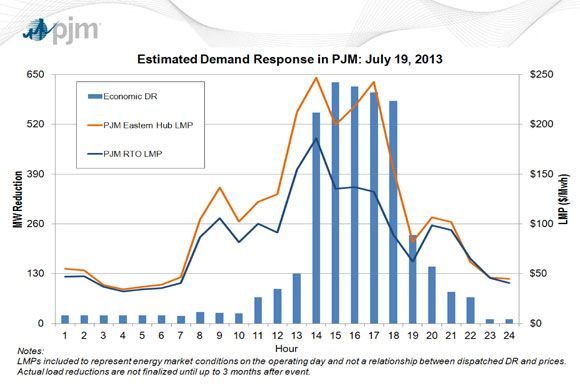Last week, a heat wave hung around the mid-Atlantic and Northeast, leading to a new peak demand record for New York state.
But as we reported, the grid seemed to fare pretty well. Demand response played a large part, even though it wasn’t a record-setting effort.
PJM, the grid operator for much of the mid-Atlantic, dispatched 1,638 megawatts of long-lead demand response on July 18 as its peak reached 158,156 megawatts at 5 p.m. PJM’s all-time peak is 163,670 MW. Although the heat wave did not push the limits of PJM’s available capacity, it did pay out nearly double the price of economic demand response versus last summer.
On July 17 and July 19, the price for economic demand response rose above $220 per megawatt-hour, compared to about $110 per megawatt-hour last year. Economic demand response also contributed hundreds more megawatts in last week’s heat wave compared to July last year. The change in price is largely due to Federal Energy Regulatory Commission's Order 745, which ruled that economic demand response needs to be paid the full wholesale price by grid operators.

EnerNOC (Nasdaq: ENOC), one of the demand response market leaders, found that customers were actively playing in demand response markets. The company saw more customers engaged with its demand response platform, DemandSMART, than it ever has before in the company’s history. Even though summer still has a long way to go, EnerNOC has already dispatched about as much demand response this year as it did in all of summer 2012. Comverge, another leading demand response company, had a record 91 events last week, far more than the previous record of 59.
Down in Texas, Nest also reported its first results of a residential demand response program with Austin Energy. In late June, Austin Energy called on customers as part of its Rush Hour Rewards program. Nest reported on its own website that its customers cut their AC use by an average of about 50 percent during the afternoon. Nest, like other programs, pre-cools the homes so customers barely notice the temperature creeping back up during the late afternoon.
Nest claims people are signing up in the thousands for the program, which gives each customer an $85 check for participating. In the past, some other residential demand response programs have found the incentive (a $20 bill credit for the summer, for instance), just isn’t worth the inconvenience.
With more money, more automation and better algorithms offered by Nest and other companies like EcoFactor and EnergyHub, customers are now finding the programs more attractive.
More money for demand response is also coming to ISO New England, New York ISO, Midwest ISO, Cal ISO and Southwest Power Pool because of FERC Order 745. As for ERCOT, which has the most severe capacity issues, changes are likely coming to the market structure to encourage more demand response.



